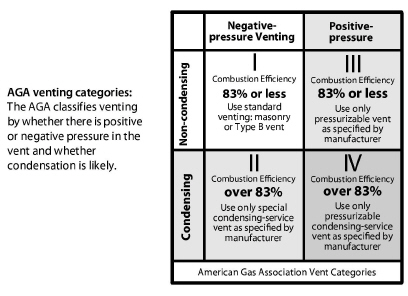
8.11 Special Venting Considerations for Gas
The American Gas Association (AGA) publishes a classification system for venting systems attached to natural-gas and propane appliances. This classification system assigns Roman numerals to four categories of venting based on whether there is positive or negative pressure in the vent and whether condensation is likely to occur in the vent
.

A majority of gas appliances found in homes and multifamily buildings are Category I, which have negative pressure in their vertical chimneys. We expect no condensation in the vent connector or chimney.
Condensing furnaces are usually Category IV, have positive pressure in their vent, and condensation occurring in both the appliance and vent. Category III vents are rare, however a few fan-assisted furnaces and boilers vent their flue gases through airtight non-condensing vents. Category II vents are very rare and beyond the scope of this discussion.
8.11.1 Venting Fan-Assisted Furnaces and Boilers
Newer gas-fired fan-assisted central furnaces and boilers eliminate dilution air and may have slightly cooler flue gases compared to their predecessors. The chimney may experience more condensation than in the past. Inspect the existing chimney to verify that it’s in good condition when considering replacing an old atmospheric unit. Reline the chimney when you see any of these conditions.
• When the existing masonry chimney is unlined.
• When the old clay or metal chimney liner is deteriorated.
• When the new furnace has a smaller input (BTUH) than the old one, the liner should be sized to the new furnace and the existing water heater.

Liner Materials for 80+ Furnaces
For gas-fired 80+ AFUE furnaces, a chimney liner should consist of one of these four materials.
1. A type-B vent
2. A rigid or flexible stainless steel liner (preferably insulated)
3. A poured masonry liner
4. An insulated flexible aluminum liner
Chimney relining is expensive. Therefore consider a power-vented sealed-combustion unit when an existing chimney is inadequate for a new fan-assisted appliance.
|
Annual Fuel Utilization Efficiency (AFUE) |
Operating characteristics |
|---|---|
|
70+ |
Category I, draft diverter, no draft fan, standing pilot, non-condensing, indoor combustion and dilution air. |
|
80+ |
Category I, no draft diverter, fan-assisted draft, electronic ignition, indoor combustion air, no dilution air. |
|
80+ |
Category III, horizontal fan-pressurized non-condensing vent, indoor combustion air, no dilution air. |
|
90+ |
Category IV, no draft diverter, fan-assisted draft, low-temperature plastic venting, positive draft, electronic ignition, condensing heat exchanger, outdoor combustion air is strongly recommended. |